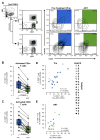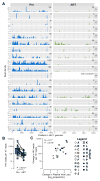Intracellular HIV-1 RNA and CD4+ T-cell activation in patients starting antiretrovirals
- PMID: 28358734
- PMCID: PMC5572749
- DOI: 10.1097/QAD.0000000000001480
Intracellular HIV-1 RNA and CD4+ T-cell activation in patients starting antiretrovirals
Abstract
Objective: To assess if the reduction in HIV-1 RNA in CD4 T cells is correlated with the persistence of immune activation following early antiretroviral therapy (ART).
Design: Clinical trial (NCT01285050).
Methods: Next-generation sequencing was used to study total RNA from activated CD4 T cells (CD38 and human leukocyte antigen - antigen D related (HLA-DR) expressing) collected from 19 treatment-naïve HIV-1/hepatitis C virus-infected patients before and early after ART initiation (≥12 weeks after plasma HIV-1 RNA <50 copies/ml). To validate comparisons, pre and post-ART measures were adjusted for input RNA and overall read number.
Results: As expected, ART use was associated with a median [interquartile range (IQR)] 4.3% (2.2-8.3) reduction in the proportion of activated CD4 T cells (P = 0.0008). Whereas in those activated CD4 T cells no consistent differences in overall gene expression were detected, interferon-stimulated gene expression declined (P < 2 × 10). Pre-ART, sorted activated CD4 T cells contained a median (IQR) of 959 (252-1614) HIV-1 reads/10 reads compared with 72 (55-152) HIV-1 reads/10 reads after at least 12 weeks of suppressive ART (P = 8 × 10). The decrease in HIV-1 reads in activated CD4 T cells was associated with the change in plasma HIV-1 RNA levels (r = 0.77, P = 2 × 10) and the change in the proportion of activated CD4 T cells (r = 0.70, P = 0.0016).
Conclusion: Months of ART led to a marked decrease in cell-associated HIV-1 RNA and interferon-stimulated genes expression in activated CD4 T cells that were strongly associated with the reduction in the proportion of activated CD4 T cells.
Conflict of interest statement
Figures




Similar articles
-
Dysfunctional phenotypes of CD4+ and CD8+ T cells are comparable in patients initiating ART during early or chronic HIV-1 infection.Medicine (Baltimore). 2016 Jun;95(23):e3738. doi: 10.1097/MD.0000000000003738. Medicine (Baltimore). 2016. PMID: 27281071 Free PMC article.
-
Longitudinal CNS and systemic T-lymphocyte and monocyte activation before and after antiretroviral therapy beginning in primary HIV infection.Front Immunol. 2025 Feb 25;16:1531828. doi: 10.3389/fimmu.2025.1531828. eCollection 2025. Front Immunol. 2025. PMID: 40070827 Free PMC article.
-
Changes in levels of T cell subpopulations to monitor the response to antiretroviral therapy among HIV-1-infected patients during two years of HIV-1 replication suppression.Scand J Infect Dis. 2013 May;45(5):368-77. doi: 10.3109/00365548.2012.744465. Epub 2012 Nov 28. Scand J Infect Dis. 2013. PMID: 23186319
-
Activated PD-1+ CD4+ T cells represent a short-lived part of the viral reservoir and predict poor immunologic recovery upon initiation of ART.AIDS. 2020 Feb 1;34(2):197-202. doi: 10.1097/QAD.0000000000002432. AIDS. 2020. PMID: 31764072
-
Close association of CD8+/CD38 bright with HIV-1 replication and complex relationship with CD4+ T-cell count.Cytometry B Clin Cytom. 2009 Jul;76(4):249-60. doi: 10.1002/cyto.b.20467. Cytometry B Clin Cytom. 2009. PMID: 19072838
Cited by
-
Intron-containing RNA from the HIV-1 provirus activates type I interferon and inflammatory cytokines.Nat Commun. 2018 Dec 13;9(1):5305. doi: 10.1038/s41467-018-07753-2. Nat Commun. 2018. PMID: 30546110 Free PMC article.
-
IFIH1 (MDA5) is required for innate immune detection of intron-containing RNA expressed from the HIV-1 provirus.Proc Natl Acad Sci U S A. 2024 Jul 16;121(29):e2404349121. doi: 10.1073/pnas.2404349121. Epub 2024 Jul 10. Proc Natl Acad Sci U S A. 2024. PMID: 38985764 Free PMC article.
-
IFIH1 (MDA5) is required for innate immune detection of intron-containing RNA expressed from the HIV-1 provirus.bioRxiv [Preprint]. 2023 Dec 12:2023.11.17.567619. doi: 10.1101/2023.11.17.567619. bioRxiv. 2023. Update in: Proc Natl Acad Sci U S A. 2024 Jul 16;121(29):e2404349121. doi: 10.1073/pnas.2404349121. PMID: 38014177 Free PMC article. Updated. Preprint.
-
Circular RNA Profiles in Viremia and ART Suppression Predict Competing circRNA-miRNA-mRNA Networks Exclusive to HIV-1 Viremic Patients.Viruses. 2022 Mar 25;14(4):683. doi: 10.3390/v14040683. Viruses. 2022. PMID: 35458413 Free PMC article.
-
HIV-1 Infection and Type 1 Interferon: Navigating Through Uncertain Waters.AIDS Res Hum Retroviruses. 2019 Jan;35(1):25-32. doi: 10.1089/AID.2018.0161. Epub 2018 Aug 15. AIDS Res Hum Retroviruses. 2019. PMID: 29999412 Free PMC article. Review.
References
-
- Warriner AH, Burkholder GA, Overton ET. HIV-related metabolic comorbidities in the current ART era. Infect Dis Clin North Am. 2014;28:457–476. - PubMed
-
- Aounallah M, Dagenais-Lussier X, El-Far M, Mehraj V, Jenabian MA, Routy JP, et al. Current topics in HIV pathogenesis, part 2: Inflammation drives a Warburg-like effect on the metabolism of HIV-infected subjects. Cytokine Growth Factor Rev. 2016;28:1–10. - PubMed
Publication types
MeSH terms
Substances
Associated data
Grants and funding
LinkOut - more resources
Full Text Sources
Other Literature Sources
Medical
Research Materials

